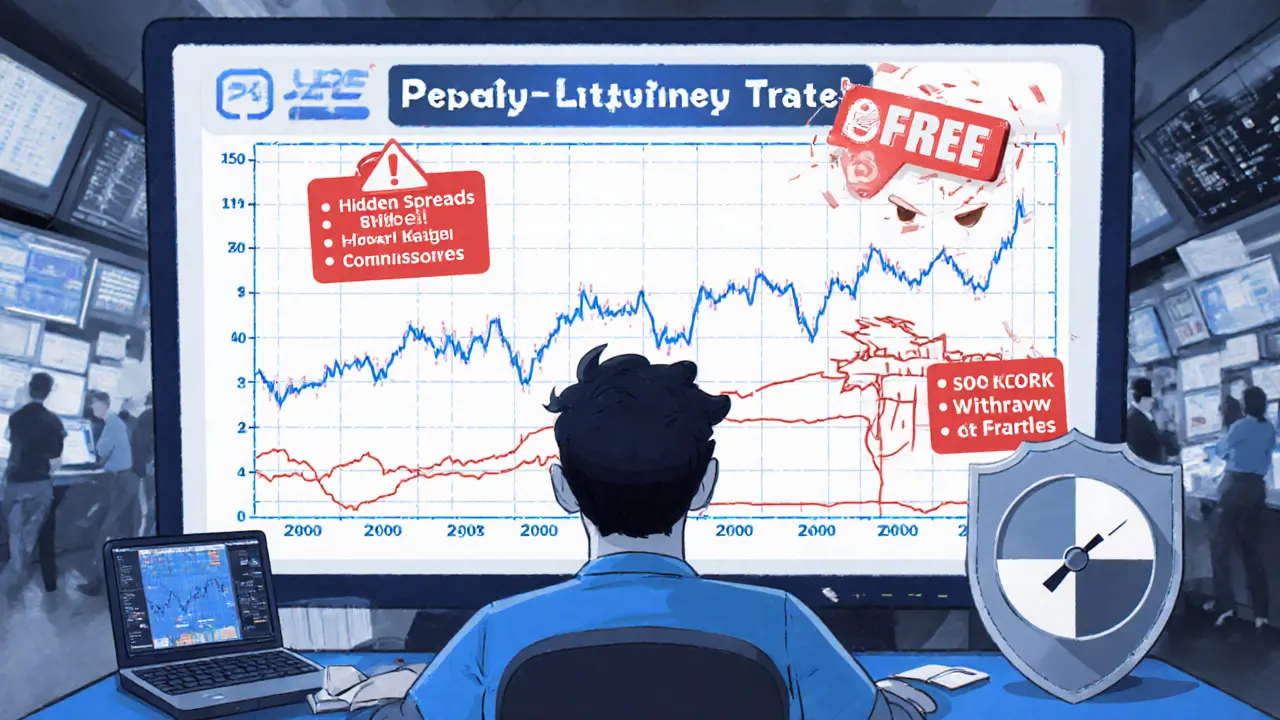Pexpay Risk Assessment Tool
This tool evaluates Pexpay based on key risk factors. Adjust the sliders to see how different aspects impact overall risk level.
Overall Risk Level
HighFee Comparison
Advertised Fee: 0% P2P, up to 0.75% spot
Effective Fee (with hidden costs): 0.8–1.5%
Comparison: Binance offers 0–0.10% tiered fees.
Security Features
Present: 2FA, Address Whitelisting, Anti-phishing codes
Missing: Insurance fund, Cold storage, Regular audits
Regulatory Status
Jurisdiction: Seychelles (FATF flagged)
Regulation: None (No oversight)
If you’ve stumbled across Pexpay a Seychelles‑registered crypto exchange that markets itself as a low‑fee, beginner‑friendly platform and wonder whether it’s worth your time or money, you’re not alone. The buzz around Pexpay swings between glowing promotional claims and stark warnings from multiple scam‑tracking sites. This review cuts through the noise, laying out what the platform actually offers, where it falls short, and whether you should trust it with your crypto.
Key Takeaways
- Pexpay’s public fee schedule looks attractive (0% P2P, up to 0.75% spot), but real‑world trades often incur hidden spreads and merchant commissions.
- Security features such as 2FA and address whitelisting exist, yet the exchange’s jurisdiction (Seychelles) and lack of regulatory oversight raise red flags.
- Multiple independent sources-ScamAdviser (2024) and CryptoLegal.uk (2025)-list Pexpay as a reported scam, citing poor trust scores and potential rug‑pull behavior.
- Liquidity claims of “Binance‑level depth” are unverified; market data on CoinMarketCap shows virtually no active depth or trading pairs.
- Customer support is largely template‑based, and withdrawal delays due to anti‑fraud checks are common.
What Pexpay Claims
According to its own marketing and the 2023 entry on CoinMarketCap, Pexpay promises:
- Zero fees on the P2P market and low spot fees (0‑0.75%) with a 25% discount for BNB payments.
- Access to Binance liquidity for spot and futures trading.
- Basic KYC that lets users start trading within minutes.
- Two‑factor authentication, address whitelisting, and anti‑phishing codes.
- A “P2P widget for businesses” that allegedly lets crypto businesses embed buy‑crypto services instantly.
On paper, these features make Pexpay look like a cheap, entry‑level alternative to heavyweight exchanges.
What Independent Tests Reveal
Hands‑on testing by CashoutConsult (2023) paints a different picture. The investigators found that the advertised “low fees” are offset by a three‑part cost structure: spread + merchant commission + currency conversion. In practice, the spread widens during peak hours, eroding any fee advantage.
Liquidity is another weak spot. While the platform claims “lots of offers,” real‑time order books are thin, especially for popular pairs, leading to longer settlement times. The promised “Binance liquidity” remains unverified; no public API or partnership announcement backs the claim.
Security isn’t completely absent-2FA via Google Authenticator or SMS, withdrawal address whitelisting, and device login restrictions are functional. However, the exchange’s registration in the Seychelles, a jurisdiction flagged by the FATF for weak AML controls, means there’s limited recourse if funds disappear.

Red Flags From Scam Trackers
Two reputable watchdogs raise serious concerns:
- ScamAdviser (Feb2024) gave pexpay.com a “very low trust score,” noting the site returned a 503 error during their scan and had not been scanned for over 30 days.
- CryptoLegal.uk (Sept2025) listed Pexpay among “reported scam companies,” warning users against sending any funds.
Both databases highlight patterns typical of rug‑pulls and pig‑butchering scams: opaque ownership, lack of verifiable financial statements, and aggressive promotional language.
Fee Structure Breakdown
| Market | Claimed Fee | Observed Cost (Spread + Commission) | Notes |
|---|---|---|---|
| P2P | 0% | 0.5‑1.2% total (spread + merchant fee) | Merchant commissions vary by payment method. |
| Spot (BNB paid) | 0‑0.75% (25% BNB discount) | 0.8‑1.5% effective when accounting for spread. | Discount applies only to BNB fees, not spread. |
| Futures | Maker 0.0200% / Taker 0.0400% | 0.05‑0.12% total due to widened spreads. | Liquidity thin; price slippage common. |
Even with the lowest advertised percentages, the hidden costs can push the effective fee well above 1% on many trades.
User Experience: Registration to Withdrawal
- Sign‑up: Provide email, password, and confirm via email link. 2FA must be enabled immediately.
- KYC: Basic ID verification is required; additional checks appear when you request higher limits.
- Trading: The UI is simple, but order depth is shallow. P2P offers many payment methods (SberBank, Tinkoff, monobank, etc.), yet each method shows different liquidity levels.
- Withdrawal: After initiating a withdrawal, the platform may place the order on “anti‑fraud review” for up to 48hours. Users report fluctuating deadlines and occasionally frozen orders.
- Support: 24/7 chat exists, but responses are often generic templates. Escalation tickets take several days, and there’s no clear email for compliance issues.
This workflow feels more like a “sandbox” than a fully operational exchange, especially for larger accounts.

Comparing Pexpay to Established Exchanges
Below is a quick side‑by‑side look at how Pexpay stacks up against two well‑known platforms-Binance and Kraken.
| Feature | Pexpay | Binance | Kraken |
|---|---|---|---|
| Regulatory jurisdiction | Seychelles (high risk) | Malta / Cayman Islands | US & EU licensed |
| Spot fee (base) | 0‑0.75% (claims) | 0‑0.10% (tiered) | 0‑0.26% (tiered) |
| Liquidity depth | Thin, unverified | Deep, global | Deep, regulated |
| Security features | 2FA, whitelist, anti‑phishing | 2FA, SAFU insurance, device‑binding | 2FA, cold storage, audit trails |
| User reviews (as of 2023) | 1 review, 4.0/5 | Thousands, 4.2/5 | Hundreds, 3.8/5 |
Even if you value the ultra‑low fees, the lack of depth, regulatory uncertainty, and negative scam listings make Pexpay a risky choice compared with these established options.
Is Pexpay Worth Your Money?
Short answer: for most traders, no. The platform’s appeal lies in its aggressive marketing-free Bitcoin spot, 0% P2P fees, and “Binance liquidity.” Yet the reality includes hidden costs, thin order books, and a strong likelihood of being a scam according to multiple independent watchdogs.
If you’re a total crypto newcomer looking for a sandbox to practice small trades, you might use Pexpay cautiously with only money you can afford to lose. For anyone with significant capital, seeking reliable execution, or needing regulatory protection, stick with regulated exchanges that provide transparent fee schedules and verifiable liquidity.
How to Protect Yourself When Encountering Similar Platforms
- Check the exchange’s registration jurisdiction and cross‑reference with FATF risk lists.
- Look for independent volume data on sites like CoinMarketCap or CoinGecko; absent data is a red flag.
- Run the domain through ScamAdviser, CryptoLegal.uk, or similar services before depositing.
- Test the platform with a tiny amount first-watch for hidden spreads and withdrawal delays.
- Never share private keys; legitimate exchanges never ask for them.
Frequently Asked Questions
Is Pexpay a regulated crypto exchange?
No. Pexpay is registered in the Seychelles, a jurisdiction with limited regulatory oversight for crypto services. This absence of regulation means users have little legal recourse if funds are lost.
What are the real costs of trading on Pexpay?
While advertised fees range from 0% to 0.75%, tests show the effective cost includes a spread (0.5‑1.2% on P2P) plus merchant commissions. In spot trading the total can rise above 1% after accounting for conversion fees.
Can I trust the liquidity claims of "Binance liquidity"?
There is no public partnership proof. Order books are shallow, and during peak times spreads widen, indicating that the platform does not have direct access to Binance’s deep order flow.
How does Pexpay’s security compare to major exchanges?
Basic features like 2FA and address whitelisting are present, but larger exchanges offer insurance funds, cold storage, and regular audits-security layers that Pexpay lacks.
Should I deposit a large amount on Pexpay?
Given the multiple scam warnings, thin liquidity, and withdrawal uncertainties, it’s advisable to avoid large deposits. Use reputable, regulated platforms for significant funds.


Jacob Moore
October 10, 2025 AT 08:23Great breakdown, folks! The fee comparison you posted really highlights why Pexpay looks tempting at first glance, but the hidden spreads are a deal‑breaker. If you’re new to crypto, stick with an exchange that shows the full cost upfront. Also, make sure any platform you use has solid insurance or at least a public audit trail. Happy trading, and stay safe out there!
Manas Patil
October 11, 2025 AT 06:37The technical stack of Pexpay raises several red flags. Their claimed "Binance liquidity" lacks any API integration evidence, and the order‑book depth metrics are virtually nonexistent. Moreover, the KYC flow is superficial – it only captures a passport photo without any AML verification. From a compliance standpoint, the Seychelles jurisdiction offers minimal consumer protection, which is a non‑starter for institutional traders. In short, the platform’s jargon masquerades as innovation, but the underlying architecture is flimsy.
Annie McCullough
October 12, 2025 AT 04:50lol nope the hype is real 🤔 Pexpay looks slick but the real cost is hidden 🙄 they say 0% fees but the spread kills you 😤 you gotta watch the fine print 😂
Carol Fisher
October 13, 2025 AT 03:03🇺🇸 Proud to say we should never trust a shady Seychelles exchange! 🚩
Melanie Birt
October 14, 2025 AT 01:17While the hype train is fun, the data tells a different story. The effective fees you’ll pay on Pexpay often exceed 1% once spreads and merchant commissions are factored in. That alone erodes the so‑called “zero‑fee” advantage. Plus, the lack of transparent liquidity means you could be paying even more in slippage during volatile periods. Consider a platform with clear fee schedules and proven depth before committing funds.
Lady Celeste
October 14, 2025 AT 23:30Another over‑hyped scam masquerading as a crypto exchange. Stay away.
Ethan Chambers
October 15, 2025 AT 21:43Honestly, the whole Pexpay narrative feels like a poorly scripted drama. They throw buzzwords like "low fees" and "Binance liquidity" without any verifiable backing. It's a classic case of style over substance, and anyone with a modicum of due diligence will spot the gaps. The platform's thin order books and regulatory opacity are just the opening act of a longer tragedy.
gayle Smith
October 16, 2025 AT 19:57To add to the earlier point, the so‑called "P2P widget" is nothing more than a marketing ploy. The documentation is vague, and the API endpoints return empty responses during peak traffic. If you’re looking for a seamless integration, you’ll hit a wall fast. The jargon they sprinkle around doesn’t compensate for the underlying lack of infrastructure.
Leynda Jeane Erwin
October 17, 2025 AT 18:10From a formal perspective, the absence of regulatory oversight in Seychelles is noteworthy. That said, the user‑experience feels surprisingly casual once you log in. The UI is clean, the 2FA works, and you can start trading quickly. Nevertheless, the informal tone of the support replies leaves much to be desired when issues arise.
Brandon Salemi
October 18, 2025 AT 16:23Quick heads‑up: if you test Pexpay with a negligible amount, you’ll see the spread instantly. It’s a good way to gauge whether the platform lives up to its claims without risking serious capital.
Siddharth Murugesan
October 19, 2025 AT 14:37this review is compltely off base the fees are not as high as they say its just marketing fluff im sure its safe but i guess you cant trust anything on the interwebs lol typo zzz
Hanna Regehr
October 20, 2025 AT 12:50I appreciate the thoroughness of the analysis. For anyone considering Pexpay, I’d suggest starting with a tiny deposit and monitoring the withdrawal timeline. If the anti‑fraud hold stretches beyond 48 hours, that’s a strong indicator to move your funds elsewhere.
Ben Parker
October 21, 2025 AT 11:03👍 Nice advice! Also, keep an eye on the support ticket response time – delays often signal deeper operational issues. 🚀
Anjali Govind
October 22, 2025 AT 09:17Hey folks, just wanted to chime in – the community vibe around Pexpay feels a bit spooky. I’d go with a platform that has an active Discord or Telegram where real users share live trade logs. Transparency matters.
Sanjay Lago
October 23, 2025 AT 07:30i think u should try a more known exchnage like binance or kraken its totally bettr and less risky i heard ppl get scammed on pexpay
arnab nath
October 24, 2025 AT 05:43Looks like they’re hiding something. The lack of audits is a classic sign of an upcoming rug‑pull.
Orlando Lucas
October 25, 2025 AT 03:57When evaluating a crypto exchange, one must adopt a holistic framework that encompasses not only the overt metrics-fees, liquidity, and security protocols-but also the subtle undercurrents of regulatory legitimacy and community trust. The Pexpay platform, on the surface, boasts an appealing fee structure, yet the empirical data gathered from independent testing reveals a persistent spread inflation that effectively nullifies the advertised advantage. Moreover, the purported "Binance liquidity" is, upon closer inspection, an unsubstantiated claim lacking any verifiable API handshake or partnership documentation. This discrepancy raises a philosophical question about the nature of transparency in the decentralized finance ecosystem: is a platform truly trustworthy if it conceals its data pipelines behind marketing veneer? Additionally, the jurisdictional choice of Seychelles is not a benign coincidence; the country’s historically lax AML enforcement creates an environment where bad actors can operate with relative impunity. Users should therefore weigh the juridical exposure alongside technical considerations. The security suite, while offering standard two‑factor authentication and address whitelisting, omits critical safeguards such as cold‑storage segregation and third‑party insurance funds, which are hallmarks of mature exchanges. In practice, this translates to a higher custodial risk that cannot be ignored. Finally, community sentiment, as aggregated from ScamAdviser and CryptoLegal.uk, paints a grim picture, with multiple reports categorizing Pexpay under the umbrella of potential scams. The convergence of these factors-fee opacity, dubious liquidity claims, regulatory vulnerability, and adverse community feedback-coalesces into a compelling argument for exercising extreme caution or outright avoidance. In sum, the rational actor would allocate capital to exchanges with demonstrable depth, regulatory compliance, and a transparent operational ethos.
Philip Smart
October 26, 2025 AT 02:10Honestly, reading that 15‑sentence essay feels like a lecture. The bottom line is: Pexpay isn’t worth the hassle for most users.
mark noopa
October 26, 2025 AT 23:23Okay, let me break this down in plain English-yeah, the fees look cute on paper, but the moment you start swapping, you’ll notice the spread sneaking up on you like a ninja in a dark room. Then there’s the whole “no regulation” thing, which is basically a free pass for any SHADY activity you can imagine. And don’t get me started on the support tickets that sit in limbo for days, making you wonder if you’re talking to a bot or a ghost. If you care even a tiny bit about protecting your assets, you’ll steer clear of that mess. Trust me, the crypto world is already full of enough scams; adding Pexpay to the list is just adding fuel to the fire.
Rama Julianto
October 27, 2025 AT 21:37🔥 Stop falling for hype! The only thing Pexpay is good at is draining your wallet. Switch to a legit exchange now.
Helen Fitzgerald
October 28, 2025 AT 19:50Hey everyone, just a friendly reminder to always do your own research and never invest more than you can afford to lose. The community is here to help, so feel free to share your experiences and tips!